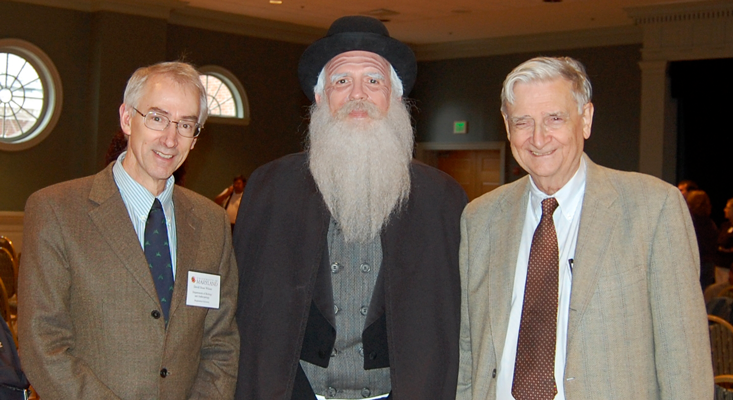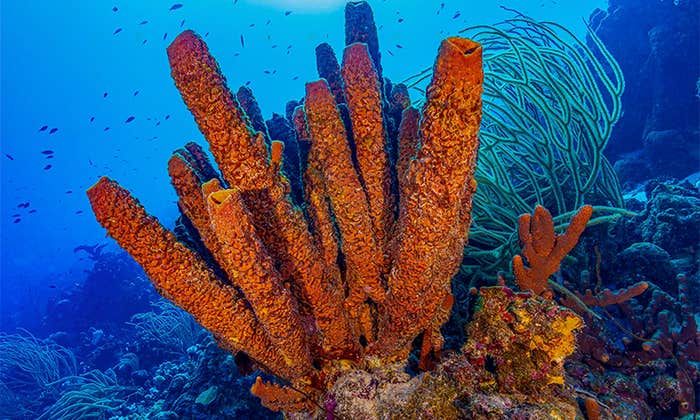I first met Edward O. Wilson in 1971 when I was a student in an ecology course at the Marine Biological Laboratory in Woods Hole, Massachusetts. Wilson, a famous Harvard professor, was sitting in on the student project reports. After I reported my experiments on food size selection in zooplankton, Wilson remarked, “That’s new, isn’t it?” I was so proud to have impressed the great E.O. Wilson that I have remembered his comment ever since!
Our next personal interaction came near the end of my graduate career at Michigan State University. I had constructed a mathematical model that provided support for the theory of group selection, which explains how altruism and other “for the good of the group” behaviors can evolve. This theory had been almost universally rejected by evolutionary biologists. Convinced of its importance, I wrote to Wilson asking if he would consider sponsoring it for the Proceedings of the National Academy of Sciences. He invited me to visit him at Harvard’s Museum of Comparative Zoology. After giving me a tour of his ant laboratory, he stood me in front of a blackboard, sat down in a chair, and said, “You have 30 minutes until my next appointment.”

I talked like an auctioneer, filling the board with my equations. Wilson was sufficiently intrigued to sponsor my article for PNAS after sending it out for review by two experts in theoretical biology. The article was published in 1975, the same year that Ed published his landmark book Sociobiology: The New Synthesis. The article became my Ph.D. thesis, which is probably the shortest in the history of evolutionary science (four pages).
Wilson, who passed away at the age of 92 on Dec. 26, 2021, is widely recognized as a giant of both the sciences and arts, which he worked to unify. He regarded the creative dimension of science as an artistic endeavor, and wrote beautifully for the public, resulting in two Pulitzer Prizes in nonfiction. He also wrote a novel, Anthill, drawn from his groundbreaking research of ant behavior. Wilson left several legacies, intellectual and personal, that, when combined, provide a vision for the rest of us to follow. These include his path-breaking work in evolutionary biology, his view that there is a consilience or a unity to all knowledge, the new frontier of ecosystems he was working on at the time of his death, and the way he encouraged young scientists.1
Did you like the grenade that I tossed in their midst?” Ed once asked me with a conspiratorial smile. We were at the 2006 annual conference of the Human Behavior and Evolution Society (HBES), where he had been invited to give a plenary talk. Even though HBES members were in the avant garde of studying human behavior from an evolutionary perspective, most of them were doctrinaire in their rejection of group selection. Ed had gone along with this tide in Sociobiology. Now, on his own, he had embraced group selection, converging upon my own advocacy. He had chosen his plenary to break the news to the unsuspecting audience, me included. You could have heard a pin drop.
Afterward, we found a corner of the lobby to talk alone. On the spot, I suggested that we write an article together, “Rethinking the Theoretical Foundation of Sociobiology,” which the Quarterly Review of Biology published the next year. In 2008, for American Scientist, we wrote “Evolution for the Good of the Group.” I remember discussing the drafts with Ed by email and phone. His voicemails sometimes went on for several minutes in flawless extemporaneous prose.
Rabbi Hillel was reputedly asked to explain the meaning of the Torah while standing on one foot, and replied, “What is hateful to you, do not do to your neighbor. Everything else is commentary.” The one-foot version of sociobiology Ed and I came up with was: “Selfishness beats altruism within groups. Altruistic groups beat selfish groups. Everything else is commentary.” This meme has become widely known and Ed repeated it all the way up to his final publications and interviews.
The last time I saw him was at a conference at MIT, which was close enough to his home that he could attend without arduous travel. In the few minutes that we spoke together, he told me excitedly about ecosystems as the next big topic that he planned to synthesize. He retained his youthful spirit of exploration right up to the end.
Nearly everything distinctive about our species is a form of cooperation.
That probably helped Ed make things happen that otherwise would have occurred much more slowly or not at all. He was, in that sense, a catalyst par excellence. Technically, a catalyst is a substance that increases the rate of a chemical reaction without being used up in the process. It holds other molecules in an orientation that binds them to each other and releases the catalyst to repeat the operation. A person can play a catalytic role in cultural change in much the same way. Calling Ed a “catalyst” or even an “icon” alongside the likes of Richard Dawkins and the late Stephen Jay Gould is fair—it honors the individual without discounting systemic trends in the history of science. They made outsized contributions as individuals, but they also represent something larger than themselves. I think that Ed would agree. In Sociobiology, for example, he was relying on the work of many hundreds of scientists to support his claim that there can be a single theory of social behavior informed by evolution.
The molecular revolution in the 1950s had a tremendous impact on him personally. He suspected that Harvard, where he taught, would be throwing all its resources toward molecular and cell biology. He realized, as he said in a 2014 interview, “that those of us, my generation of what we came to call evolutionary biologists and organismic biologists, were not going to get anywhere by complaining by any means but we were going to have to—and we should be tremendously excited to plan this—develop an equivalent to molecular biology on our own.”
This required finding and collaborating with scientists who had complementary expertise—especially the ability to build mathematical models of ecological and evolutionary processes. This new generation included names like Robert MacArthur, Larry Slobodkin, and Richard Lewontin. These were some of the rock stars whose work I avidly read as a graduate student in the 1970s.
One of Ed’s most productive collaborations was with Robert MacArthur, an ecologist with mathematical training, leading to their landmark 1967 book The Theory of Island Biogeography. It made sense of the great mass of natural history information on the distribution and abundance of species on islands—some of it, the ant species, Ed collected himself around the world. The theory applied not only to actual islands but to all habitats that are island-like, such as mountains separated by valleys or patches of forest separated by deforested areas.
While Ed played a prominent role in modernizing whole organism biology, he was by no means alone. Evolutionary theory was proving its explanatory scope and many people were taking part in the effort, leading the geneticist Theodosius Dobzhansky to coin the oft-repeated phrase, “Nothing in biology makes sense except in the light of evolution.” What this meant to me as a graduate student was that I could choose any topic, begin asking intelligent questions based on evolutionary theory (often with the help of mathematical models), and then test my hypotheses on any appropriate organism. I didn’t need to become a taxonomic specialist and I could change topics at will. In short, I could become a polymath based on a theory that anyone can learn.
In Sociobiology, Ed claimed that evolutionary theory provides a single conceptual toolkit for studying the social behaviors of all creatures great and small. It combined the authority of an academic tome with the look and feel of a coffee table book, complete with over 200 illustrations by the artist Sarah Landry. Its publication was noted on the front page of The New York Times.
It was Sociobiology’s last chapter on human social behavior that landed Ed in trouble—in part for a good reason. For all its explanatory scope, the study of evolution was restricted to genetic evolution for most of the 20th century, as if the only way that offspring can resemble their parents is by sharing the same genes. This is patently false when stated directly, since it ignores the cultural transmission of traits entirely, but it essentially describes what became known as the Modern Synthesis. There was a large grain of truth to the critique that Sociobiology was genetically deterministic. On the other hand, it’s not as if the critics had a synthesis of their own to offer!
Beavers flood their environment to protect themselves.
Only after the publication of Sociobiology did evolutionary thinkers begin to take cultural evolution seriously. Ed was among them with books such as On Human Nature, and others.2 Today, Darwinian evolution is widely defined as any process that combines the three ingredients of variation, selection, and replication, no matter the mechanism. This definition is true to Darwin’s thought (since he knew nothing about genes) and can accommodate a plurality of inheritance mechanisms such as epigenetics (based on changes in gene expression rather than gene frequency), forms of social learning found in many species, and forms of symbolic thought that are distinctively human.
While human cultural inheritance mechanisms evolved by genetic evolution, that doesn’t make them subordinate, as if genes—in one of Ed’s metaphors—hold cultures on a leash. On the contrary, as the faster evolutionary process, cultural evolution often takes the lead in adapting humans to their environments, with genetic evolution playing a following role (gene-culture co-evolution).
Part of the maturation of human cultural evolutionary theory is the recognition of group selection as an exceptionally strong force in human evolution—something else that Ed got right. According to Harvard evolutionary anthropologist Richard Wrangham in his book, The Goodness Paradox, naked aggression is over 100 times more frequent in a chimpanzee community than small-scale human communities. This is due largely to social-control mechanisms in human communities that suppress bullying and other forms of disruptive self-serving behaviors, so that cooperation becomes the primary social strategy (this is called a major evolutionary transition).
Nearly everything distinctive about our species is a form of cooperation, including our ability to maintain an inventory of symbols with shared meaning that is transmitted across generations. Our capacity for symbolic thought became a full-blown inheritance system that operates alongside genetic inheritance (dual inheritance theory). Cultural evolution is a multilevel process, no less than genetic evolution, and the increasing scale of cooperation over the course of human history can be seen as a process of multilevel cultural evolution.
While the critique of genetic determinism was accurate for Sociobiology and evolutionary biology as a whole in 1975, this is no longer the case for the modern study of humans from an evolutionary perspective—which brings us to Ed’s belief in consilience. In his 1998 book, Consilience: The Unity of Knowledge, Ed reported having “a conviction, far deeper than a mere working proposition, that the world is orderly and can be explained by a small number of natural laws.” While this vision stretches back to antiquity, there is something about evolutionary theory that fulfills the vision for the living world in an extraordinary way.
Ed described what happened when he was 18, newly arrived at the University of Alabama, with a passion for identifying plants and animals using field guides. “Suddenly—that is not too strong a word—I saw the world in a wholly new way,” he wrote. He’d read Ernst Mayr’s 1942 Systematics and the Origin of Species. “A tumbler fell somewhere in my mind, and a door opened to a new world,” Ed wrote. “I was enthralled, couldn’t stop thinking about the implications evolution has for classification and for the rest of biology. And for philosophy. And for just about everything.”
Coincidentally, Mayr’s Animal Species and Evolution was one of the first evolution books that I read as an undergraduate student. While it was not thin—811 pages!—I was similarly enthralled. By the 1970s, what Darwin and Ed glimpsed from the start was now proving itself for the length and breadth of the biological sciences. Every time an evolutionary biologist decides to switch to a new topic and/or organism—which happens all the time—consilience is being demonstrated in action.
Only now are we in a position to synthesize human-related knowledge in the same way as biological knowledge, thanks to an expanded definition of Darwinism as any variation/selection/replication process. You can’t make sense of humanity without acknowledging its group-ish nature and the importance of culturally transmitted symbolic meaning systems. As Emile Durkheim wisely put it, “Social life, then, in every aspect and throughout its history, is only possible thanks to a vast body of symbolism.” Ed’s vision in Consilience is right on and its fulfillment is now in progress.
Before he died, Ed’s next book was to be titled Ecosystems and the Harmony of Nature. I don’t know if it will be published posthumously but we can get a glimpse of what he had in mind from its title and what he’s recently said. On the E.O. Wilson Biodiversity Foundation website, Ed is quoted as saying he wants young people to join “the coming development of a new biological science, one of the next big things, which is ecosystem studies.”
I must confess that I am puzzled by this, since the study of whole ecosystems dates back to the beginning of the 20th century and has become increasingly integrated with evolutionary ecology over the last 50 years. It turns out that group selection (or more generally multilevel selection) is essential for understanding the nature of ecosystems, no less than single species societies.
Many single-species societies in nature are like a human society in the grip of civil war. A single human society at war with itself is a complex adaptive system, in the sense that it is composed of agents following their respective adaptive strategies. But clearly, and this is a crucial distinction, the society suffering a civil war is not itself adaptive as a system. After all, it’s breaking apart.
Members of most social groups in nature are largely in conflict with each other and at most cooperate in specific contexts. We need look no further than chimpanzee communities for an example, where social strife is stable—there is no reason to expect it to change, given the selection pressures that are operating. But that doesn’t make them harmonious or desirable from a human perspective.
E.O. Wilson was a catalyst par excellence.
Many multispecies ecosystems are also like this. Beavers, for example, modify the environment for their own benefit, flooding it to protect themselves from predators and eating the most palatable plants. Consequences for biodiversity and ecosystem processes, such as nutrient cycling, are collateral effects of beavers pursuing their interests. There is no reason to expect the whole ecosystem to be functionally organized and harmonious, any more than a chimpanzee community or a human society in the grip of civil war.
This is a hard lesson to learn about nature. We want it to be harmonious. Religious cosmologies often portray nature as harmonious (e.g., the Garden of Eden) except when disturbed by humans. The early study of ecosystems often treated them axiomatically as harmonious. But Darwin’s theory of evolution tells a different story. It tells us that functional organization for any given system, at any given scale, requires a process of selection at that scale. That is the only way to achieve an adaptive system rather than a system where functionally organized agents impose suffering on each other in the course of pursuing their respective adaptive strategies. That goes for human society, single-species animal societies, and multispecies ecosystems.
Are there examples of ecosystems that have evolved into superorganisms? Yes! Microbiomes are an example. Even whole forests are being imagined as mutualistic networks nowadays, with trees connected into a network by mycorrhizal fungi. Is such a thing possible? Yes, but only if selection has operated at the scale of whole forests with sufficient strength to counteract selection at lower scales. Otherwise, forests become merely systems composed of species that interact at cross purposes, rather than adaptive at the system level.
It is important to avoid confusing “harmony” with “equilibrium.” Ecologists have started to use the word “regime” to describe stable assemblages of species. Some of the worst human political regimes are also depressingly the most stable. To use the language of complex systems theory, there are multiple local stable equilibria, and positive change requires escaping the gravitational pull of one local equilibrium to enter another. This requires active management and will not necessarily happen by itself. The management of ecosystems must itself be a human cultural evolutionary process informed by multilevel selection theory.
And for me, that’s the next frontier—not just ecosystems but becoming wise stewards of evolution in all its forms. Variation/selection/replication processes are taking place all around us at different time scales, including genetic evolution, cultural evolution, and intra-generational personal evolution. Wise stewardship will be required for all forms of positive change—individual, cultural, and ecosystemic. The ability to see this clearly and to act on it has only become available during the last few decades and is currently shared by only a tiny fraction of those who need to know about it.
We need a catalysis so that positive evolution can take place in a matter of years rather than decades or not at all. If science, and evolutionary science, have revolutionized the way we see and therefore act on the world, then we can look forward to further improvements in the near future. This leads to a form of hope and optimism, even in the darkest of times, that is part of Ed’s legacy. The best way to honor Ed is to join in this catalysis.
Of course, no remembrance of Ed would be complete without noting the way that he encouraged people to become scientists, to follow their hearts, and to cultivate a reverence for nature. Searching #EOWilson on Twitter offers a glimpse of how he touched others. Jill Obersky, for example, a doctoral student at UC Davis studying ants, said she was lucky to have met Ed a few years ago, “a kind soul and a scientific legend” who “inspired so many of us who likewise never grew out of our childhood ‘bug phase.’ Rest in peace, Ed.”
David Sloan Wilson is SUNY Distinguished Professor Emeritus of Biology and Anthropology at Binghamton University and president of Prosocial World, a new spinoff of The Evolution Institute. His most recent nonfiction books are Does Altruism Exist? Culture, Genes, and the Welfare of Others, This View of Life: Completing the Darwinian Revolution, and Prosocial: Using Evolutionary Science to Build Productive, Equitable, and Collaborative Groups (with Paul W.B. Atkins and Steven C. Hayes). Atlas Hugged, Wilson’s first novel, is available only on its website, where it is gifted for whatever the reader wishes to give in return and with all proceeds going to Prosocial World.
Footnotes
1. For an expanded version of this remembrance, see https://thisviewoflife.com/the-six-legacies-of-edward-o-wilson/.
2. Other major thinkers included Richard Dawkins and his concept of memes, Luigi Luca Cavalli-Sforva and Marcus Feldman (Cultural Transmission and Evolution), and Robert Boyd and Peter Richerson (Culture and the Evolutionary Process, Not By Genes Alone). The importance of symbolic thought began to occupy center stage with books such as The Symbolic Species by Terrence Deacon and Evolution in Four Dimensions by Eva Jablonka and Marion Lamb.
Lead image: daraka / Shutterstock


























